
Concept explainers
Journalization:
It means record of financial data related to business transactions in a journal in a manner so that debit equals credit. It provides an audit trail to the auditor and a means to analyze the effects of transactions to an organization‘s financial health.
Rules of
- Assets: Increase in asset should be debit and decrease should be credit.
- Liabilities: Increase in liabilities should be credit and decrease should be debit.
- Equity: Increase in Equity should be credit and decrease should be debit.
- Expense: Increase in expense should be debit and decrease should be credit.
- Revenue: Increase in revenue should be credit and decrease should be debit.
Write off method for accounts receivable: This is a method of accounting for writing off
To prepare: Journal entry to record the unexpected payment from an uncollectible account receivable for which the record has been made with direct write off method.
Want to see the full answer?
Check out a sample textbook solution
Chapter 7 Solutions
GEN COMBO FINANCIAL AND MANAGERIAL ACCOUNTING; CONNECT ACCESS CARD
- 2024 net income ? Financial accountingarrow_forwardI am looking for the correct answer to this general accounting question with appropriate explanations.arrow_forwardAltura Corporation's total liabilities are $385,000, and its equity is $742,000. What are the total assets? A. $1,127,000 B. $1,300,000 C. $ 1,234,000arrow_forward
- Can you solve this general accounting problem using appropriate accounting principles?arrow_forwardDuring FY 2024, Diego Corporation reported revenue of $375,000, a contribution margin of $15.00 per unit, fixed costs of $120,000, and a net income of $45,000. Use this information to determine the number of units Diego sold during FY 2024.arrow_forwardPlease explain the solution to this financial accounting problem with accurate principles.arrow_forward
- Please provide correct answer general accounting question and not need chat gpt solutionarrow_forwardAccounting solutions and answerarrow_forwardA business has revenue of $895,000, cost of goods sold of $356,000, operating expenses of $198,000, and pays $82,000 in taxes, what is the net income?arrow_forward

 AccountingAccountingISBN:9781337272094Author:WARREN, Carl S., Reeve, James M., Duchac, Jonathan E.Publisher:Cengage Learning,
AccountingAccountingISBN:9781337272094Author:WARREN, Carl S., Reeve, James M., Duchac, Jonathan E.Publisher:Cengage Learning, Accounting Information SystemsAccountingISBN:9781337619202Author:Hall, James A.Publisher:Cengage Learning,
Accounting Information SystemsAccountingISBN:9781337619202Author:Hall, James A.Publisher:Cengage Learning, Horngren's Cost Accounting: A Managerial Emphasis...AccountingISBN:9780134475585Author:Srikant M. Datar, Madhav V. RajanPublisher:PEARSON
Horngren's Cost Accounting: A Managerial Emphasis...AccountingISBN:9780134475585Author:Srikant M. Datar, Madhav V. RajanPublisher:PEARSON Intermediate AccountingAccountingISBN:9781259722660Author:J. David Spiceland, Mark W. Nelson, Wayne M ThomasPublisher:McGraw-Hill Education
Intermediate AccountingAccountingISBN:9781259722660Author:J. David Spiceland, Mark W. Nelson, Wayne M ThomasPublisher:McGraw-Hill Education Financial and Managerial AccountingAccountingISBN:9781259726705Author:John J Wild, Ken W. Shaw, Barbara Chiappetta Fundamental Accounting PrinciplesPublisher:McGraw-Hill Education
Financial and Managerial AccountingAccountingISBN:9781259726705Author:John J Wild, Ken W. Shaw, Barbara Chiappetta Fundamental Accounting PrinciplesPublisher:McGraw-Hill Education





